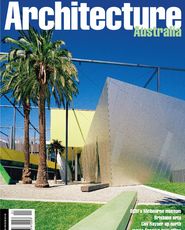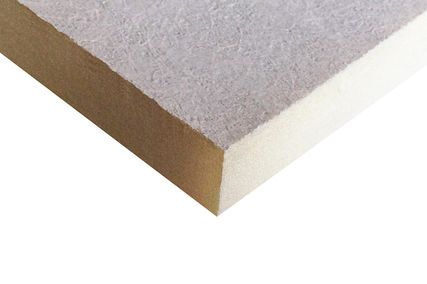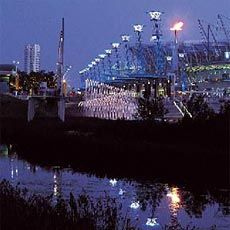
Looking across Haslam’s Pier, to the northern end of the Olympic Boulevard.
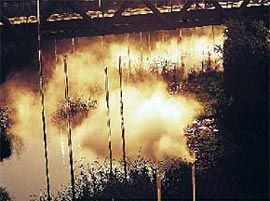
In the Shadow by Janet Laurence.
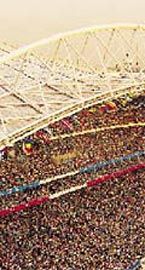
Stadium Australia, the east stand. Photos Patrick Bingham-Hall.
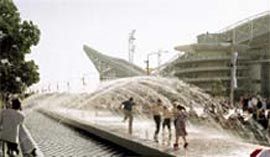
Fig grove water feature.
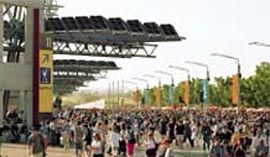
The crowd on the main plaza at Homebush.
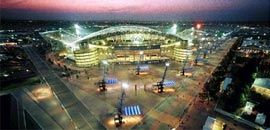
Stadium Australia from the Olympic hotel roof.
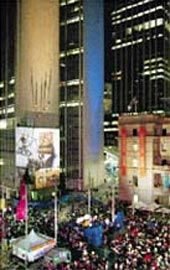
Wall climbing street performance at the Old Customs House, near Circular Quay. Photos John Gollings.
It’s funny going to the world’s biggest party in your own house. The music’s great, the dancing’s great, the people are fantastic, but you know the wallpaper, you know the furniture, and you prepared the food. No trips into the unknown, you just hope that everything works out. And apparently it did.
Occasionally it really was the Olympic Games. Most evenings, after completing my photographic commitments I’d stroll into the Stadium, flash my Infinity Accreditation‚ pass, find a good seat, and watch very fast Africans run round and round in circles. A lot of the time, though, it was Sydney.
Hundreds and thousands of Aussie, Aussie, Aussies.
How did the architecture work? Peter Stutchbury rang to ask if I’d seen his archery pavilion. He’d been watching the archery finals on TV, and couldn’t see his architecture anywhere. Pete, it was buried beneath three hundred cubic miles of scaffold and white plastic. The Olympic Games really are for television, soup for the masses. At every venue, I felt that I was watching TV, and when I did watch the Games on TV at home, I didn’t feel like I was missing anything. And the beer was a lot cheaper.
It was curious to assess the architecture at such an orchestrated event. Architectural aesthetics are rendered irrelevant by the ceremonial excess. The main stadium performed brilliantly, the biggest was the best. Funnily enough, the best views were from the temporary stands – nearly all athletic events are best observed longitudinally rather than laterally. The swimming was schizophrenic. The atmosphere around the pool was quiet and unremarkable, almost suburban, but way up above, on one side only, there were thousands of Aussie, Aussie, Aussies cheering in the dark. In the cheap seats. The only venue where I felt that the architecture actually enhanced and determined the occasion was the Baseball Stadium. It was surprisingly intimate with a large crowd, rather like an English soccer ground, and the bright red light towers were so cheerful in contrast to the pervading greys and whites of generic sporting architecture.
Everywhere else? It was just like watching TV really.
Tangible aesthetic triumphs were to be found at either end of the main boulevard.
At the southern end, Janet Laurence’s misting, wafting, bubbling artwork in the creek below DCM’s Bailey bridges was captivating. At the northern end, between the village and the venues, the long jetty protruding into the wetlands provided a marvellous respite, and a quick glimpse into the real world of mud and ducks.
There were some memorable moments.
A beautiful girl with a northern European accent interrupted my photography and asked me to explain Janet Laurence’s artwork. A crowd gathered, and queued up to photograph us. Turns out I was discussing site-specific art with Inge de Bruijn, the champion Dutch swimmer. Janet, she’s a fan. Then, photographing the Baseball Stadium with my large-format camera, I had my head under the black cloak, fiddling with the focus, when I was knocked sideways. I thought I’d been shot in the leg, but everyone was cheering. I’d been hit by a Japanese home-run. I had a bruise on my calf the size of a baseball for weeks afterwards. My Olympic legacy.
Patrick Bingham-Hall.
My task was to document people using the public domain spaces created for the Olympics, not only at Homebush but also the downtown “live” sites.
Going to the Olympics might have been fun for the spectators but it was a nightmare for all the photographers involved.
Constraints included budget, weather, time, travel, bureaucracy and access.
I wanted to show the crowds within the context of the urban spaces and with the formality and quality of a large architectural camera. Dramatic reportage shots of crowds alone would not satisfy the brief. I’m very conscious of an historic imperative for a photo to be meaningful and useful many years later. This requires both place and action in each photo, all wrapped in a strong composition and with a formal, almost symbolic, arrangement of the spectators.
For me the pleasure of architectural photography is deducing the point of view; to find the magic place where a photographic composition best demonstrates an architectural solution. If you add the dynamic of a large crowd of people, whose very fluxing affects the composition, then you have the ingredients for a lot of frustration and wasted film. This is because you have to wait for the perfect composition to form itself rather than the photographer organising the content.
As usual I was haunted by a fear of failure – technically and aesthetically. Many of the solutions required quite tricky night exposures. There is a masochistic pleasure waiting for the processing to determine success or failure, especially when you can’t repeat the shot.
Documenting such a large amorphous event as a whole city in Olympic mode is quite daunting. I confess to drawing on a lot of experience with similar projects in order to establish some frameworks for what might be the valuable shots. Bridget Smythe and George Hargreaves both gave me extraordinary latitude and encouragement to interpret their work strongly and clearly.
John Gollings.

